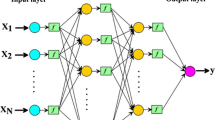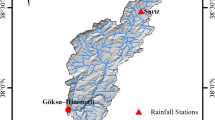Abstract
This study develops and applies three hybrid models, including wavelet packet-artificial neural network (WPANN), wavelet packet-adaptive neuro-fuzzy inference system (WPANFIS) and wavelet packet-support vector machine (WPSVM), combining wavelet packet decomposition (WPD) and machine learning models, ANN, ANFIS and SVM models, for forecasting daily river stage and evaluates their performance. The WPANN, WPANFIS and WPSVM models using inputs decomposed by the WPD are found to produce higher efficiency based on statistical performance criteria than the ANN, ANFIS and SVM models using original inputs. Performance evaluation for various mother wavelets indicates that the model performance is dependent on mother wavelets and the WPD using Symmlet-10 and Coiflet-18 is more effective to enhance the efficiency of the conventional machine learning models than other mother wavelets. It is found that the WPANFIS model outperforms the WPANN and WPSVM models, and the WPANFIS14-coif18 model produces the best performance among all other models in terms of model efficiency. Therefore, the WPD can significantly enhance the accuracy of the conventional machine learning models, and the conjunction of the WPD and machine learning models can be an effective tool for forecasting daily river stage accurately .













Similar content being viewed by others
Explore related subjects
Discover the latest articles and news from researchers in related subjects, suggested using machine learning.References
Adamowski J, Chan HF (2011) A wavelet neural network conjunction model for groundwater level forecasting. J Hydrol 407(1):28–40
Adamowski J, Prasher SO (2012) Comparison of machine learning methods for runoff forecasting in mountainous watersheds with limited data. J Water Land Dev 17:89–97
Adamowski J, Sun K (2010) Development of a coupled wavelet transform and neural network method for flow forecasting of non-perennial rivers in semi-arid watershed. J Hydrol 390(1):85–91
Alikhani A (2009) Combination of neuro fuzzy and wavelet model usage in river engineering. Int J Energy Environ 3(3):122–134
Amiri GG, Asadi A (2009) Comparison of different methods of wavelet and wavelet packet transform in processing ground motion records. Int J Civ Eng 7(4):248–257
Belayneh A, Adamowski J (2012) Standard precipitation index drought forecasting using neural networks, wavelet networks, and support vector regression. Appl Comput Intell Soft Comput 2012, Article ID 794061. doi:10.1155/2012/974061
Bratton D, Kennedy J (2007) Defining a standard for particle swarm optimization. In: Proceedings of the 2007 I.E. swarm intelligence symposium. Honolulu, H.I., USA, pp. 120–127
Chapelle O, Vapnik V, Bousquet O, Mukherjee S (2002) Choosing multiple parameters for support vector machines. Mach Learn 46:131–159
Chen P, Chen H, Ye, R (2010) Chaotic wind speed series forecasting based on wavelet packet decomposition and support vector regression. In: Proceedings of IPEC 2010 Conference, Singapore, pp 256–261
Choy K, Chan C (2003) Modelling of river discharge and rainfall using radial basis function networks based on support vector regression. Int J Syst Sci 34(1):763–773
Dawson CW, Wilby RL (2001) Hydrological modelling using artificial neural networks. Prog Phys Geogr 25(1):80–108
Dibike Y, Velickov S, Solomatine D, Abbott M (2001) Model induction with support vector machines: introduction and applications. J Comput Civ Eng 15(3):208–216
Dunn JC (1973) A fuzzy relative of the ISODATA process and its use in detecting compact well-separated clusters. J Cybern 3:32–57
Gokhale MY, Khanduja DK (2010) Time domain signal analysis using wavelet packet decomposition approach. Int Commun Netw Syst Sci 3(3):321–329
Goldberg D (1989) Genetic algorithms in search, optimization, and machine learning, First edn. Addison-Wesley, Boston, M.A., USA
Günther F, Fritsch S (2010) Neuralnet: training of neural networks. R J 2(1):30–38
Han D, Cluckie ID (2004) Support vector machines identification for runoff modelling. In: Proceedings of the 6th international conference on Hydroinformatics, Singapore, 21–24. World Scientific, June, pp. 1597–1604
Hsieh HI, Lee TP, Lee TS (2011) A hybrid particle swarm optimization and support vector regression model for financial time series forecasting. Int J Bus Adm 2(2):48–56
Ismail S, Shabri A, Samsudin R (2012) A hybrid model of self organizing maps and least square support vector machine for river flow forecasting. Hydrol Earth Syst Sci 19:4417–4433
Jang JSR (1993) ANFIS: adaptive-network-based fuzzy inference system. IEEE Trans Syst Man Cybern 23(3):665–685
Jang JSR, Sun CT, Mizutani E (1997) Neuro-fuzzy and soft computing: a computational approach to learning and machine intelligence. Prentice-Hall, New Jersey
Jayashree N, Bhuvaneswaran RS (2016) Z-transform based digital image watermarking scheme with DWT and Chaos. In: Nagar A, Mohapatra DP, Chaki N (eds) Proceedings of 3rd International Conference on Advanced Computing, Networking and Informatics, Smart Innovation, Systems and Technologies 43. doi:10.1007/978-81-322-2538-6_30
Jothiprakash V, Magar RB (2012) Multi-time-step ahead daily and hourly intermittent reservoir inflow prediction by artificial intelligent techniques using lumped and distributed data. J Hydrol 450-451:293–307
Kaltech AM (2015) Wavelet genetic algorithm-support vector regression (wavelet GA-SVR) for monthly flow forecasting. Water Resour Manag 29(4):1283–1293
Karaboga D, Akay B (2009) A comparative study of artificial bee colony algorithm. Appl Math Comput 214:108–132
Khanghah TR, Nourani V, Parhizkar M, Sharghi E (2012) Application of information content to extract wavelet-based feature of rainfall-runoff process. In: Proceedings of the 12th WSEAS international conference on applied computer science. WSEAS, Greece, pp. 148–153
Kim S, Kim HS (2008) Neural networks and genetic algorithm approach for nonlinear evaporation and evapotranspiration modeling. J Hydrol 351(3–4):299–317
Kim S, Park KB, Seo Y (2012a) Estimation of pan evaporation using neural networks and climate-based models. Disaster Adv 5(3):34–43
Kim S, Shiri J, Kisi O (2012b) Pan evaporation modeling using neural computing approach for different climatic zones. Water Resour Manag 26(11):3231–3249
Kim S, Shiri J, Kisi O, Singh VP (2013) Estimating daily pan evaporation using different data-driven methods and lag-time patterns. Water Resour Manag 27(7):2267–2286
Kisi O (2007) Streamflow forecasting using different artificial neural network algorithms. J Hydrol Eng 12(5):532–539
Kisi O, Shiri J, Nazemi AH (2011) A wavelet-genetic programming model for predicting short-term and long-term air temperatures. J Civ Eng Urban 1(1):25–37
Liu H, Tian H, Pan D, Li Y (2013) Forecasting models for wind speed using wavelet, wavelet packet, time series and artificial neural networks. Appl Energy 107:191–208
Maier HR, Dandy GC (2000) Neural networks for the prediction and forecasting of water resources variables: a review of modelling issues and applications. Environ Model Softw 15:101–123
Mamdani EH, Assilian S (1975) An experiment in linguistic synthesis with a fuzzy logic controller. Int J Man Mach Stud 7(1):1–13
Mathworks (2014) Fuzzy logic toolbox user’s guide. The Mathworks, Inc http://wwwmathworkscom/help/pdf_doc/fuzzy/fuzzypdf Assessed 07 June 2014
Navarro RI (2013) Study of a neural network-based system for stability augmentation of an airplane. Polytechnic University of Catalonia, MS Thesis
Noori R, Karbassi AR, Moghaddamnia A, Han D, Zokaei-Ashtiani MH, Farokhnia A, Ghafari Gousheh M (2011) Assessment of input variables determination on the SVM model performance using PCA, gamma test and forward selection techniques for monthly stream flow prediction. J Hydrol 401:177–189
Nourani V, Alami MT, Aminfar MH (2009) A combined neural-wavelet model for prediction of Ligvanchai watershed precipitation. Eng Appl Artif Intell 22(3):466–472
Nourani V, Parhizkar M, Khanghah TR, Baghanam AH, Sharghi E (2012) Wavelet-based feature extraction of rainfall-runoff process via self-organizing map. In: Proceedings of the 12th WSEAS international conference on applied computer science. WSEAS, Greece, pp. 101–106
Okkan U (2012) Using wavelet transform to improve generalization capability of feed forward neural networks in monthly runoff prediction. Sci Res Essays 7(17):1690–1703
Okkan U, Serbes ZA (2013) The combined use of wavelet transform and black box models in reservoir inflow modeling. J Hydrol Hydromech 61(2):112–119
Othman F, Naseri M (2011) Reservoir inflow forecasting using artificial neural network. Int J Phys Sci 6(3):434–440
Partal T, Cigizoglu HK (2008) Estimation and forecasting of daily suspended sediment data using wavelet-neural networks. J Hydrol 358:317–331
Petrovic-Lazarevic S, Zhang JY (2009) Neuro-fuzzy models and tobacco control. In: Mastorakis N, Mladenov V, Kontargyri VT (eds) Proceedings of the European Computing Conference, Volume 27 of the Series Lecture Notes in Electrical Engineering, Springer US, pp 25–31
Rafiee J, Tse PW, Harifi A, Sadeghi MH (2009) A novel technique for selecting mother wavelet function using an intelligent fault diagnosis system. Expert Syst Appl 36:4862–4875
Raghavendra NS, Deka PC (2015) Forecasting monthly groundwater level fluctuations in coastal aquifers using hybrid wavelet packet-support vector regression. Cogent Eng 2(1). doi:10.1080/23311916.2014.999414
Rajaee T, Nourani V, Mohammad ZK, Kisi O (2011) River suspended sediment load prediction: application of ANN and wavelet conjunction model. J Hydrol Eng 16(8):613–627
Rao SS (2009) Engineering optimization: theory and practice, 4th edn. John Wiley & Sons Inc., Hoboken
Ravikumar K, Tamilselvan S (2014) On the use of wavelets packet decomposition for time series prediction. Appl Math Sci 8(58):2847–2858
Scikit-learn developers (2012) Scikit-learn: machine learning in python. Scikit-learn user guide. http://www.math.unipd.it/~aiolli/corsi/1213/aa/user_guide-0.12-git.pdf. Accessed 10 June 2016
Seo Y (2015) River stage forecasting model combining wavelet packet transform and artificial neural network. J Environ Sci Int 24(8):1023–1036 (In Korean)
Seo Y, Kim S, Singh VP (2013a) Flood forecasting and uncertainty assessment using bootstrapped ANFIS. In: Proceedings of 6th conference of Asia Pacific Association of Hydrology and Water Resources. Seoul, South Korea, pp. 1–8
Seo Y, Park KB, Kim S (2013b) Comparative study on fuzzy rule-based systems for flood level forecasting. Proceedings of Korea Water Resources Association, South Korea, In, pp. 421–425 (in Korean)
Seo Y, Park KB, Kim S, Singh VP (2013c) Application of bootstrap-based artificial neural networks to flood forecasting and uncertainty assessment. In: Proceedings of 6th International Perspective on Water Resources and the Environment, EWRI-ASCE, Izmir, Turkey
Seo Y, Kim S, Kisi O, Singh VP (2015a) Daily water level forecasting using wavelet decomposition and artificial intelligence techniques. J Hydrol 520:224–243
Seo Y, Kim S, Singh VP (2015b) Physical interpretation of river stage forecasting using soft computing and optimization algorithms. In: Kim JH, Geem ZW (eds) Harmony search algorithm. Springer, Berlin, Heidelberg, pp. 259–266
Sivapragasam C, Liong S, Pasha M (2001) Rainfall and runoff forecasting with SSA-SVM approach. J Hydroinf 3(3):141–152
Sudheer KP, Gosain AK, Ramasastri KS (2002) A data-driven algorithm for constructing artificial neural network rainfall-runoff models. Hydrol Process 16(6):1325–1330
Sudheer C, Maheswaran R, Panigrahi BK, Mathur S (2014) A hybrid SVM-PSO model for forecasting monthly streamflow. Neural Comput & Applic 24:1381–1389
Takagi T, Sugeno M (1985) Fuzzy identification of systems and its application to modeling and control. IEEE Trans Syst Man Cybern 15(1):116–132
Tiwari MK, Chatterjee C (2010) Development of an accurate and reliable hourly flood forecasting model using wavelet-bootstrap-ANN (WBANN) hybrid approach. J Hydrol 394(3–4):458–470
Tu JV (1996) Advantages and disadvantages of using artificial neural networks versus logistic regression for predicting medical outcomes. J Clin Epidemiol 49(11):1225–1231
Vapnik VN (1998) Statistical learning theory. Wiley, New York
Wei S, Song J, Khan NI (2012) Simulating and predicting river discharge time series using a wavelet-neural network hybrid modelling approach. Hydrol Process 26(2):281–296
Yu X, Liong S, Babovic V (2004) EC-SVM approach for real-time hydrologic forecasting. J Hydroinf 6(3):209–223
Yuan FC (2012) Parameters optimization using genetic algorithms in support vector regression for sales volume forecasting. Appl Math 3(10 A):1480–1486
Author information
Authors and Affiliations
Corresponding author
Rights and permissions
About this article
Cite this article
Seo, Y., Kim, S., Kisi, O. et al. River Stage Forecasting Using Wavelet Packet Decomposition and Machine Learning Models. Water Resour Manage 30, 4011–4035 (2016). https://doi.org/10.1007/s11269-016-1409-4
Received:
Accepted:
Published:
Issue Date:
DOI: https://doi.org/10.1007/s11269-016-1409-4




